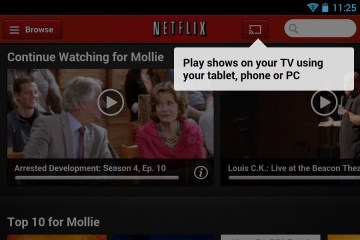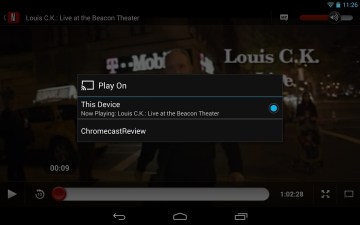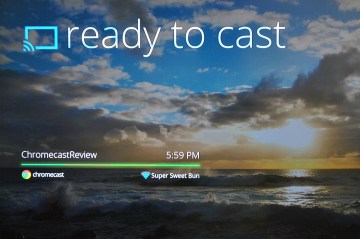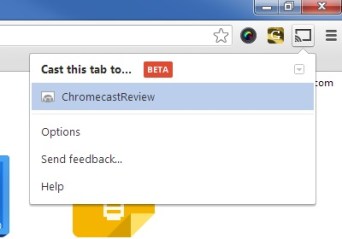Every night, it’s the same situation. My wife and I are on the couch, TV off, immersed in our respective computing devices, when she breaks the silence: “Let’s watch something.”
From there, it’s a process. I look for the Xbox 360 controller and twiddle my thumbs while it boots, or if it’s out of reach, maybe I get up and turn on our media PC instead. I return to my comfy seat and fumble with one remote or another, none of them really ideal for shuffling through vast menus of video content. By the time we’re actually watching something, 10 minutes have passed.
This is the life of a cord cutter. We save insane amounts of money every month by not subscribing to cable TV, but the alternative of watching Internet video sometimes feels like a chore. I’m really hoping Chromecast is the solution.
Chromecast is a $35 dongle that plugs into an HDMI slot on your television (see our video overview here), and its main purpose is to reduce the amount of time between wanting to watch a video on Netflix or YouTube and actually doing it.

The big assumption with Chromecast is that when you’re on the couch, you already have a phone or tablet in your hands. Instead of reaching for a remote, all you have to do is open your Netflix or YouTube app, find the video you want to watch, and press a little “Cast” button to send the video to your television.
Chromecast is supposed to handle the rest. Over Wi-Fi, your phone tells the dongle what to watch. The dongle automatically turns on your television, switches to the appropriate input and begins streaming the video you’ve chosen.
It’s a subtle but important distinction from AirPlay, the method Apple uses to beam videos to an Apple TV. With AirPlay, the video gets streamed directly from your iOS device or Mac. Chromecast streams straight from the Internet; your phone or tablet merely sends the instructions to the dongle. Because the phone or tablet isn’t actively sending data the entire time with Chromecast, you’re not wasting battery life, and you’re free to do other things on your phone or tablet while the video plays on your TV. (Correction: AirPlay does allow you to stream certain video apps in the background, but it’s up to app developers to support this feature.)

Chromecast has another big advantage: It supports Android as well as iOS devices. I bounce between both platforms, so the fact that AirPlay only works with Apple products was the main thing holding me back from Apple TV.
In my experience, Chromecast isn’t quite as magical as Google makes it seem. While setting up the device, I got an error message saying I needed to tinker with my router settings to get the Wi-Fi connection working. But then I just tried to connect again, and everything worked.
One other nitpick: The dongle itself connects through HDMI, but it’s powered by USB, and not all TVs have powered USB jacks on them. If your TV has a “service” USB port, it won’t work. The only other option is to plug the dongle into a wall outlet, which detracts from its overall slickness.
I also had to adjust my television’s settings to get Chromecast to automatically turn on my TV and switch inputs. As GigaOM’s Janko Roettgers explains, Chromecast uses a little-known technology called HDMI-CEC to control your television, but every TV maker refers to this technology differently. To get the controls working on my Sharp TV, I had to find the “Aquos Link” menu and toggle the setting for “Auto Power On.”

After getting those issues straightened out, Chromecast worked flawlessly. When you open Netflix or YouTube on an iOS or Android device, the app recognizes that there’s a Chromecast in the house, and presents the option to send videos to your television. You can start controlling Chromecast playback on one phone, then switch to another and pick up the controls from there.
Depending on your situation, this may not be ideal. Letting any phone or tablet control Chromecast could lead to a power struggle in your living room. And if you have a lot of people over, choosing a video on your phone might not be as fun as letting everyone see their options on the big screen. But even then, Chromecast could still be great for those moments when you suddenly want to share a YouTube video with everyone in the room.
The bigger drawback for Chromecast is that it only works with a handful of apps: YouTube, Netflix, Google Play Music and Google Play Video. Pandora support is coming soon, and other developers are free to add Chromecast support to their apps, but it’s too early to assume that the Chromecast ecosystem is going to boom.

Chromecast also lets you send any browser tab to the big screen from Chrome on a Windows PC, Mac or Chromebook. But right now, Google’s calling this a beta feature, and it’s easy to see why. In my experience on both a Chromebook and a powerful Windows desktop, streaming video regularly fell out of sync with the audio. And unlike the video streaming from a phone or tablet, you must leave the current tab open for it to stream on the television. That puts a strain on your computer’s battery life and prevents you from doing other things at the same time. The Chrome-based streaming is a fine feature for viewing online photos or other static web pages, but I would not recommend getting a Chromecast for the sole purpose of sending video from a laptop to your television.
Those issues haven’t prevented me from buying a Chromecast for myself. (The one I’m using now is on loan from Google.) Netflix streaming alone accounts for the vast majority of my video-watching at home, and $35 is well worth the convenience of being able to select and watch videos faster than I have before. If more developers end up supporting Chromecast, it’ll just be icing.
On that note, some critics see the lack of a dedicated remote and TV interface as a problem for Chromecast. I see it as an opportunity. It allows app developers to support Chromecast without the extra work of creating separate television apps, which they largely haven’t done for the perpetually-flailing Google TV. And as someone who gave up clunky cable remotes a long time ago, I’m ready for those button-laden monstrosities to be replaced by phones and tablets. Chromecast is the first device that envisions the touch screen as your primary remote control. It probably won’t be the last.

